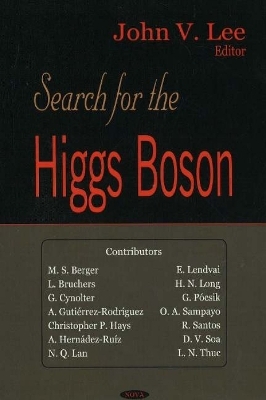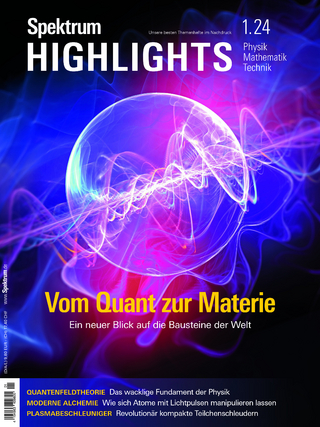
Search for the Higgs Boson
Seiten
2006
Nova Science Publishers Inc (Verlag)
978-1-59454-861-1 (ISBN)
Nova Science Publishers Inc (Verlag)
978-1-59454-861-1 (ISBN)
The Higgs boson is an undiscovered elementary particle, thought to be a vital piece of the closely fitting jigsaw of particle physics. Each type of particle has its own corresponding field. The Higgs field is a simple one - it has the same properties viewed from every direction, and in important respects is indistinguishable from empty space.
The Higgs boson is an undiscovered elementary particle, thought to be a vital piece of the closely fitting jigsaw of particle physics. Like all particles, it has wave properties akin to those ripples on the surface of a pond which has been disturbed; indeed, only when the ripples travel as a well defined group is it sensible to speak of a particle at all. In quantum language the analogue of the water surface which carries the waves is called a field. Each type of particle has its own corresponding field. The Higgs field is a particularly simple one -- it has the same properties viewed from every direction, and in important respects in indistinguishable from empty space. Thus physicists conceive of the Higgs field being "switched on", pervading all of space and endowing it with "grain" like that of a plank of wood. The direction of the grain in undetectable, and only becomes important once the Higgs' interactions with other particles are taken into account. for instance, particles call vector bosons can travel with the grain, in which case they move easily for large distances and may be observed as photons - that is, particles of light that we can see or record using a camera; or against, in which case their effective range is much shorter, and we call them W or Z particles. These play a central role in the physics of nuclear reactions, such as those occurring in the core of the sun. The Higgs field enables us to view these apparently unrelated phenomenon as two sides of the same coin; both may be described in terms of the properties of the same vector bosons. When particles of matter such as electrons or quarks (elementary constituents of protons and neutrons, which in turn constitute the atomic nucleus) travel through the grain, they are constantly flipped "head-over-heels". this forces them to move more slowly than their natural speed, that of light, by making them heavy.
The Higgs boson is an undiscovered elementary particle, thought to be a vital piece of the closely fitting jigsaw of particle physics. Like all particles, it has wave properties akin to those ripples on the surface of a pond which has been disturbed; indeed, only when the ripples travel as a well defined group is it sensible to speak of a particle at all. In quantum language the analogue of the water surface which carries the waves is called a field. Each type of particle has its own corresponding field. The Higgs field is a particularly simple one -- it has the same properties viewed from every direction, and in important respects in indistinguishable from empty space. Thus physicists conceive of the Higgs field being "switched on", pervading all of space and endowing it with "grain" like that of a plank of wood. The direction of the grain in undetectable, and only becomes important once the Higgs' interactions with other particles are taken into account. for instance, particles call vector bosons can travel with the grain, in which case they move easily for large distances and may be observed as photons - that is, particles of light that we can see or record using a camera; or against, in which case their effective range is much shorter, and we call them W or Z particles. These play a central role in the physics of nuclear reactions, such as those occurring in the core of the sun. The Higgs field enables us to view these apparently unrelated phenomenon as two sides of the same coin; both may be described in terms of the properties of the same vector bosons. When particles of matter such as electrons or quarks (elementary constituents of protons and neutrons, which in turn constitute the atomic nucleus) travel through the grain, they are constantly flipped "head-over-heels". this forces them to move more slowly than their natural speed, that of light, by making them heavy.
Preface; Doubly-Charged Higgs Boson; Searches for Higgs Bosons in Two-Higgs Doublet Models: The Fermiophobic Limit; Higgs Pair-Production at Next Generation Linear Colliders; Muon Colliders and Higgs Boson Physics; Dynamical Symmetry Breaking with Vector Bosons; Candidates for Dark Matter in the Models; Index.
| Erscheint lt. Verlag | 1.12.2006 |
|---|---|
| Zusatzinfo | Illustrations |
| Verlagsort | New York |
| Sprache | englisch |
| Maße | 260 x 180 mm |
| Gewicht | 550 g |
| Themenwelt | Naturwissenschaften ► Physik / Astronomie ► Hochenergiephysik / Teilchenphysik |
| Naturwissenschaften ► Physik / Astronomie ► Quantenphysik | |
| ISBN-10 | 1-59454-861-7 / 1594548617 |
| ISBN-13 | 978-1-59454-861-1 / 9781594548611 |
| Zustand | Neuware |
| Haben Sie eine Frage zum Produkt? |
Mehr entdecken
aus dem Bereich
aus dem Bereich
Neue Sicht auf die Bausteine der Welt
Buch (2024)
Spektrum der Wissenschaft (Verlag)
9,80 €


